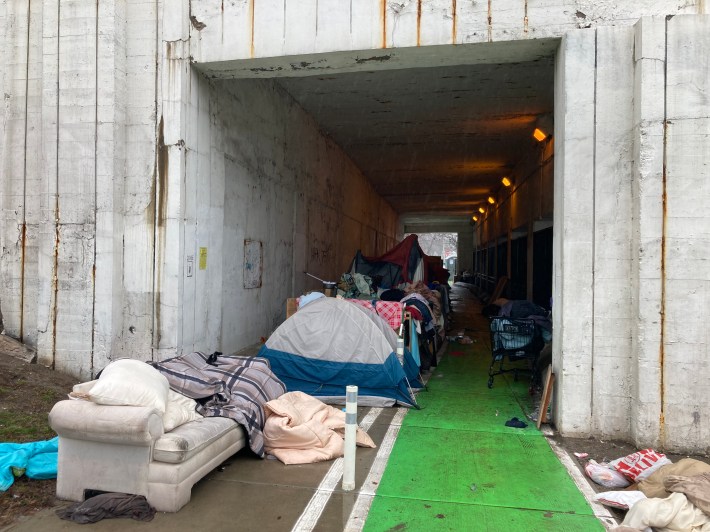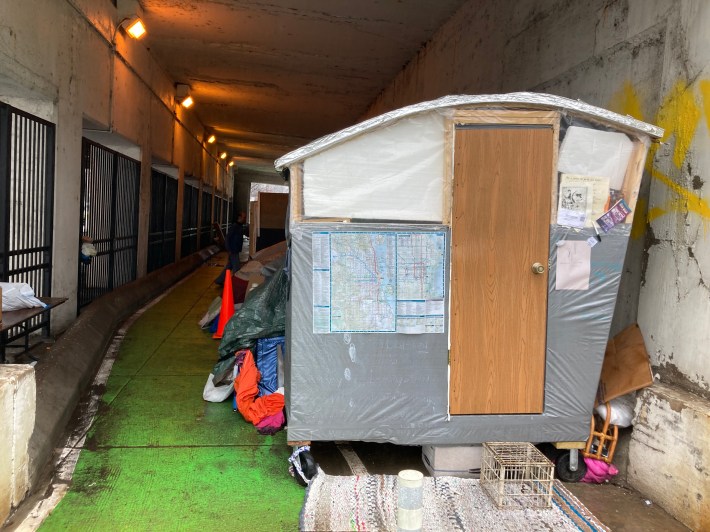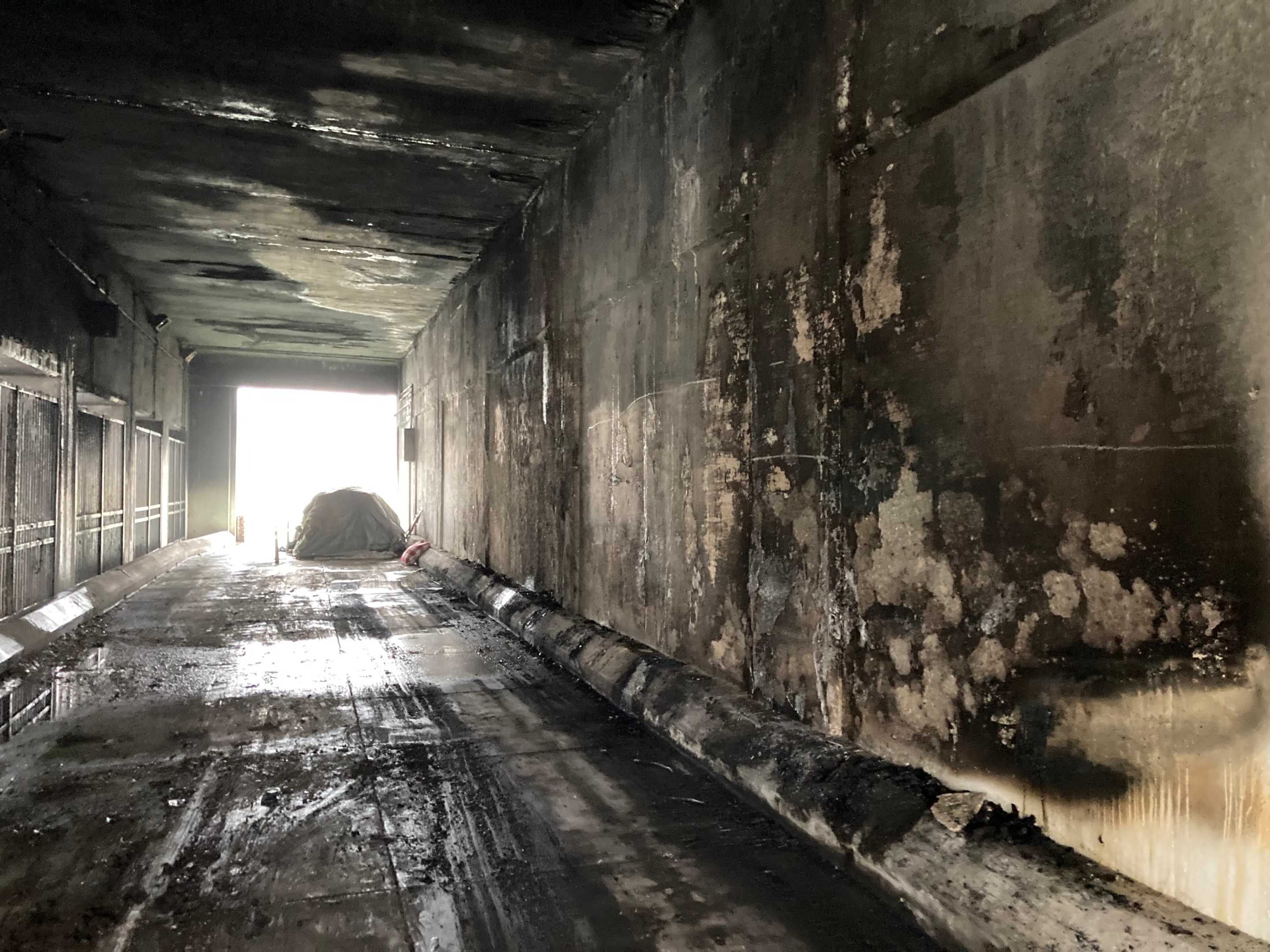On March 9 Mayor Lori Lightfoot announced the city would be directing more police resources to the CTA, and doubling the number of unarmed transit security guards in response to a spike in violent crime and problematic rule-breaking, such as harassment and smoking, on buses and trains.
As part of the discussion of the need for better levels of safety and sanitation on the system, there's been renewed attention to the fact that many Chicagoans are tired of seeing their fellow residents forced to shelter on the 'L' due to a lack of better options. People sleeping on the 24-hour Red and Blue lines, often stretched out across four or five seats, has become a more common sight during the COVID-19 pandemic, a time when more people have been experiencing financial and mental health crises, and shelters have had less capacity due to the need for social distancing. Ultimately the fact that these routes largely function as rolling hotels at night can be blamed on city officials' failure to provide homes for those who need them.

Similarly, the proliferation of tent cities across Chicago in recent years is a symptom of our leaders' reluctance to tackle the homelessness problem. The issue has particularly come to a head in Uptown, where homeless encampments have been established on the wide sidewalks of the DuSable Lake Shore Drive viaducts on Lawrence and Wilson avenues, located on routes to the lakefront.
In 2017 the Chicago Department of Transportation reconstructed the passageways, which evicted the unhoused residents, and then installed green bike lanes with plastic posts on the sidewalks, in what was almost certainly an effort to make sure the tents wouldn't return. These streets have four travel lanes through the viaducts, more space than is needed for drivers, so a better solution would have been to convert two of the mixed-traffic lanes to protected bike lanes.
Not only was the sidewalk bikeway strategy inequitable, it was a total failure on all fronts, since the encampments quickly returned, making the bike lanes unusable, and homeless advocates fought the city's efforts to keep the viaducts clear, which made it politically impossible to do so. During the pandemic many housed residents have avoided walking next to the tents on their way to Montrose Beach, walking in the street instead, so the stalemate is also a pedestrian safety issue.

When I asked local alderman James Cappleman (46th) about the matter last May, he told me that all of the dozens of people living in the viaducts had been offered housing, but many of them declined to leave. A Chicago Coalition for the homeless representative responded that "People experiencing homelessness want and need permanent housing. It is simply false to claim otherwise."
The saga took a tragic turn Tuesday morning when a fire ignited on the south sidewalk of the Lawrence viaduct, causing propane tanks used for space heaters to explode, Block Club Chicago reported. While no one was hurt, all six tents on that side were incinerated, and the occupants lost all their possessions. The dozen tents on the north side of the viaduct were unharmed. The cause of the fire has not yet been determined.

"What I've heard from the city's Department of Family and Support Services over and over again is that the very best way to help anyone living under the viaduct is to support their case manager's work of getting them into permanent housing," Cappleman said in a statement he shared on Twitter. "Every single person living under the viaduct is known by name and they all have an assigned case manager who has the task of motivating them to take the needed steps to obtain permanent housing. Case managers meet with them to build trust because many of them have been... burned by past interactions with others, including other social services." He asked constituents to consider helping the viaduct residents by contributing to the following social service organizations that are currently doing outreach to them.
I asked Cappleman if he had any interest in piloting a program similar to a San Francisco initiative that built 70 tiny homes for unhoused people, with dining halls, bathrooms, and computers for each resident, at a total of $30,000 per unit, as a strategy to provide better housing for the viaduct residents and keep the passageways clear. The alderman responded by inviting me to attend his office hours.
Ryan Bauer went from living in a tent on the hard pavement to his own tiny home, with a mattress, desk, chair and a heater that quickly warms his 64-square-foot abode. https://t.co/wFWpdOuSwb pic.twitter.com/CcPDmfe5zC
— San Francisco Chronicle (@sfchronicle) March 12, 2022
"We were deeply saddened to learn about the fire at the Lawrence viaduct and our hearts go out to those who lost their shelter and belongings," said Julie Dworkin, director of policy for the Chicago Coalition for the Homeless. (Disclosure: Dworkin is an old friend of mine.) "Living outside is unsafe for multiple reasons and each time an event like this takes place we are reminded of that. The best way to keep people safe is to provide permanent housing with supportive services."
Responding to Cappleman's statement, Dworkin said, "Building trust is important, but with more than 9,000 people experiencing homelessness on a waiting list for housing, there simply is not enough housing to get everyone off the street." She pointed to the coalition's Bring Chicago Home campaign, which calls for a one-time real estate transfer tax on the sale of homes worth more than $1 million, which would affect less than 5.2 percent of annual homes sales. The advocacy group says the revenue could house 12,000 people over 10 years.

"[We've] been pushing for more than three years for the city to create a new dedicated revenue stream for permanent housing," Dworkin said. "What will it take to move the mayor and the City Council to action?"
From more people experiencing homelessness sleeping on 'L' trains, to an increasing number of tents in viaducts, housed Chicagoans are seeing constant reminders of the city's failure to take care of our most vulnerable residents. If we're fed up with these sights, the solution is to lobby our leaders to dedicate more funding to house the homeless.





